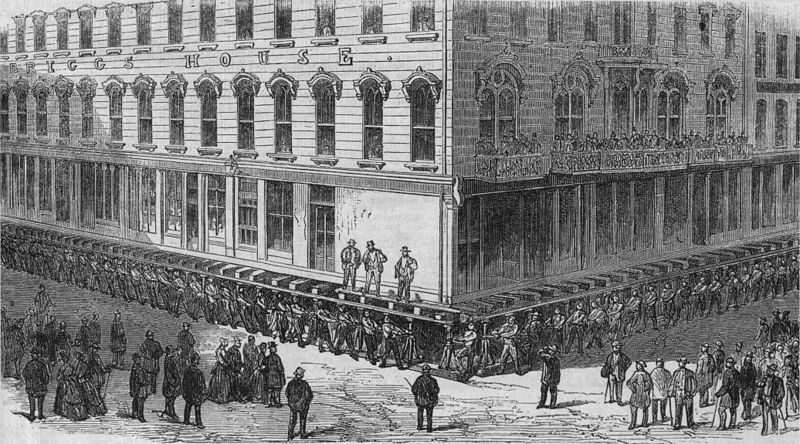Raising Chicago

The city of Chicago was founded in 1833, on the coast of Lake Michigan and within the Mississippi River watershed. Its location — near rivers which lead south and adjacent to a conduit eastward as well — lent itself to rapid growth. Only 200 people were living in Chicago at its founding on August 12 of that year, but it quickly grew. By 1840, well over 4,000 people lived there; by 1860, Chicago had 112,000 residents. For its first century, it was widely regarded to be one of the fastest growing metro areas in the world.
But growth comes with a price, especially in a city which is just five hundred feet or so (182 m) above sea level. When it rained, it flooded. Everywhere. Chicago, into the 1850s, did not have a working municipal sewage system. So water just collected and collected. Where water sits, disease brews, as Chicagoans quickly learned. Typhoid fever, dysentery and cholera struck the city year after year. In 1854, a cholera outbreak killed as much as six percent of the city’s population. Fixing the problem, though, came with a problem unto itself — how do you build sewers where the buildings already are?
The solution: Raise the buildings.
No, not raze. Raise, as in to lift up. If the city could figure out a way to elevate four- and five-story (and larger!) buildings a few feet, they could install new foundations, allowing for the construction of a municipal sewage system. A few years later, they did exactly that. In January of 1858, the first building — a four story high brick structure weighing 750 tons — was placed on two hundred fifty jackscrews (this is what a jackscrew looks like) and successfully lifted more than six feet over its original height without damaging it.
Over the next decade, much of central Chicago was similarly lifted so that the sewage system could be constructed. Most impressive, perhaps, was the lifting of a row of buildings 320 feet (nearly 100 m) long on Lake Street — accomplished by roughly six hundred men over the course of five days. One hotel, the Briggs House, required dozens of men, as seen above (larger version of what appears to be an engraving here), and survived the lifting just fine. In other cases, the city also had to raise the sidewalk, roads, and anything else installed too low for a sewer system to run underneath.
In general, the lifting was successful; there are few reports of damage. (Ironically, many of the buildings lifted — including the Briggs House seen above — were destroyed by the Great Chicago Fire of 1872). And the city took the lifting as an opportunity to do something else: it gentrified. Wooden frame buildings, which were looked at as lesser, poorer structures than the brick and iron ones, were lifted — and then removed, driven out of the city. As Wikipedia notes, the practice of putting these buildings “on rollers and moving them to the outskirts of town or to the suburbs was so common as to be considered nothing more than routine traffic.”
Bonus fact: If you’re ever in Chicago, try the garlic and onions. The word “Chicago” comes from a Native American word, transliterated into French as “shikaakwa” (say it aloud), which over time became the term we know today. “Shikaakwa” means either wild garlic or wild onion, both of which were plentiful in the region before settlers of European descent arrived in the area.
From the Archives: Onion Ring: Why you can’t buy onion futures in the United States. (Blame Chicago.)
Related: A jackscrew. And, in most cases more useful, a book on the history of Chicago. 5 stars on six reviews.
